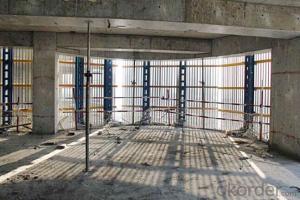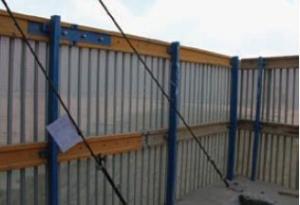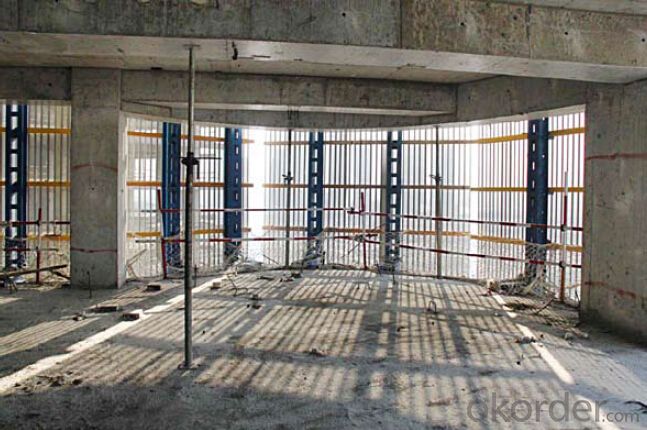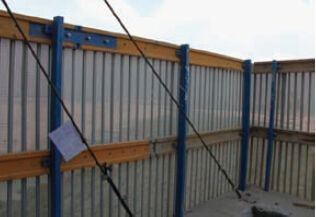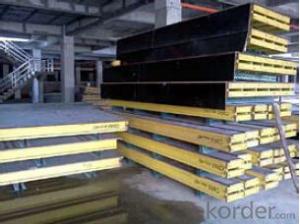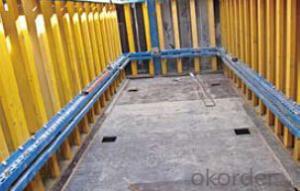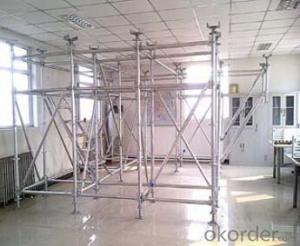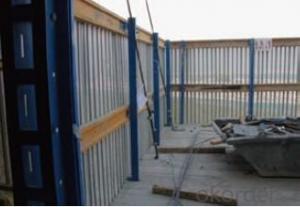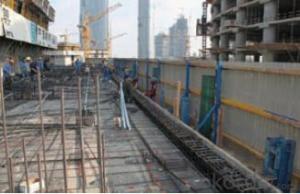Protection Platform for Formwork and Scaffolding Systems
- Loading Port:
- Tianjin
- Payment Terms:
- TT OR LC
- Min Order Qty:
- 50 m²
- Supply Capability:
- 1000 m²/month
OKorder Service Pledge
OKorder Financial Service
You Might Also Like
Protection Platform PP-50
A kind of new type construction protection system, applying operating platform and safer job
location for construction corps.
Characteristics:
◆ Easy and quick assembling.
◆ Lifted as a group, it is rapid and economic.
◆ Auto-climbing
◆ A safe and reliable anchor system
1. Composition
2. Assembly process of anchor system
(1) Embed V-climbing cone and anchor plate into the slab.
(2) Fix anchor shoe on the slab by tensile bolt.
(3) The fixed anchor shoe.
◆ High work efficiency with work platform and unload platform
◆ High light transmittance with the hollow block
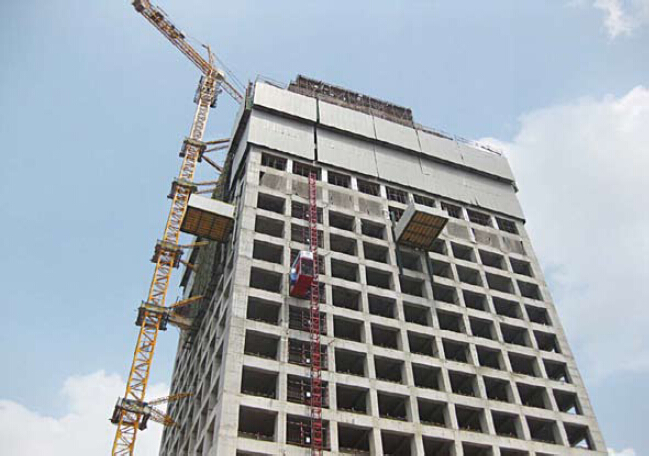
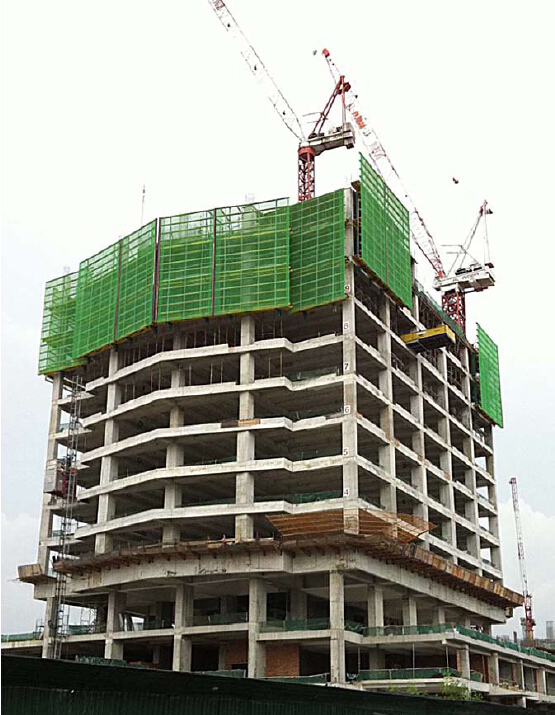
- Q: What is the standard thickness of steel formwork
- Opposite? The negative is not too clear. Generally if there is pellicle
- Q: How does steel formwork impact the overall project management?
- Steel formwork can have a significant impact on the overall project management in various ways. First and foremost, steel formwork is known for its durability and longevity, which means it can be reused multiple times throughout the project. This reduces the need for frequent replacements and repairs, saving both time and money. Moreover, steel formwork provides a high level of accuracy and precision, ensuring that the concrete structures are built according to the specified dimensions and specifications. This not only enhances the quality of the project but also minimizes the chances of rework or corrective measures, thereby saving time and resources. Additionally, steel formwork offers greater flexibility and versatility compared to traditional wooden formwork. It can be easily adjusted and modified to accommodate changes in design or unforeseen circumstances during the construction process. This adaptability enables project managers to make on-site adjustments quickly and efficiently, keeping the project on track and minimizing delays. Furthermore, steel formwork is known for its faster installation and dismantling process. This allows for faster construction cycles, enabling project managers to meet tight deadlines and complete the project within the scheduled timeframe. The faster turnaround time also improves project efficiency and reduces overall project costs. Lastly, steel formwork is considered a safer option compared to other formwork materials. It provides a stable and secure platform for workers, minimizing the risk of accidents and injuries. By prioritizing worker safety, project managers can maintain a productive and efficient work environment. In conclusion, steel formwork has a positive impact on overall project management by enhancing durability, accuracy, flexibility, speed, and safety. Utilizing steel formwork can lead to improved project outcomes, reduced costs, and enhanced efficiency, ultimately contributing to the successful completion of the project.
- Q: How does steel formwork affect the overall safety of construction workers?
- Steel formwork can greatly enhance the overall safety of construction workers. Firstly, steel formwork is known for its durability and strength, which makes it highly resistant to damage or collapse during the construction process. This ensures that workers are protected from potential accidents caused by the formwork failing or collapsing. Additionally, steel formwork is designed to be structurally stable, providing a secure and stable platform for workers to carry out their tasks. This stability reduces the risk of slips, trips, and falls, which are among the most common causes of accidents in construction sites. With a stable formwork system, workers can confidently move around and work at heights without the fear of the platform giving way. Furthermore, steel formwork is designed to be modular and easily assembled, allowing for quick and efficient construction processes. This reduces the time workers spend on the construction site, minimizing their exposure to potential hazards and risks. By reducing the duration of the project, steel formwork also decreases the overall fatigue and stress levels of workers, leading to increased alertness and improved safety. Another safety advantage of steel formwork is its resistance to fire. Steel does not burn or contribute to the spread of fire, which adds an extra layer of protection for construction workers in case of fire accidents on-site. This feature significantly reduces the risk of injuries or fatalities due to fire incidents, ensuring the safety of workers. Overall, the use of steel formwork in construction significantly enhances the safety of workers. Its durability, stability, quick assembly, and fire resistance properties all contribute to creating a safer working environment, reducing the likelihood of accidents and injuries. By investing in steel formwork, construction companies prioritize the well-being of their workers and promote a culture of safety on the construction site.
- Q: How does steel formwork affect the overall construction schedule and sequencing?
- The overall construction schedule and sequencing can be significantly affected by steel formwork. Several advantages of steel formwork, compared to traditional wooden formwork, contribute to faster construction times and improved sequencing. To begin with, steel formwork is highly durable and strong, allowing for multiple reuses without any degradation. This durability reduces assembly and dismantling time, resulting in faster construction progress. Furthermore, the robustness of steel formwork allows for higher pouring rates, enabling larger sections of concrete to be poured at once. As a result, productivity is increased, and construction schedules are shortened. In addition, steel formwork provides greater accuracy and precision in shaping concrete structures. The easily adjustable and alignable steel panels and frames ensure correct positioning and leveling of the forms. This precision significantly reduces the time needed for adjustments or rework, thus improving sequencing and minimizing delays. Moreover, steel formwork offers flexibility in design and customization. It can be easily modified or adapted to suit different construction requirements and building designs. This flexibility allows for a smoother construction process, eliminating the need for extensive modifications or alterations and saving time while enhancing sequencing. Furthermore, steel formwork can withstand harsh weather conditions and extreme temperatures, making it suitable for various construction environments. This resilience eliminates delays caused by adverse weather, allowing construction to proceed as scheduled. Overall, the use of steel formwork has a positive impact on the construction schedule and sequencing. Its durability, accuracy, flexibility, and resilience contribute to faster construction progress, reduced rework, improved productivity, and minimized delays. By utilizing steel formwork, construction projects can be completed more efficiently and within the planned timeframe.
- Q: What are the different types of edge protections available for steel formwork?
- Different types of edge protections are available for steel formwork, each designed for a specific purpose and offering varying levels of safety and functionality. Here are some common types: 1. Steel edge protection: Constructed from steel, this type is typically used in heavy-duty construction projects. It ensures the safety of workers and prevents accidental falls with its excellent durability and strength. 2. Rubber edge protection: Offering impact resistance and a cushioning effect, rubber edge protection is a lightweight and flexible option. It is commonly used in areas where workers may come into contact with the edge, such as staircases or walkways. 3. Plastic edge protection: Lightweight, easy to install, and cost-effective, plastic edge protection creates a barrier between workers and the edge, preventing slips or falls. It is commonly used in low-risk areas or temporary construction sites. 4. Foam edge protection: Made of soft and flexible material, foam edge protection provides a cushioning effect and prevents injuries from accidental bumps. It is typically used in areas with a lower risk of falls but a higher chance of impact. 5. Metal edge protection: Industrial settings with heavy machinery or equipment often utilize metal edge protection. It offers excellent durability and protection against impact, ensuring the safety of both workers and equipment. 6. Removable edge protection: This type can be easily installed and removed as needed. It is commonly used in areas requiring temporary edge protection, such as during construction or renovation projects. It is crucial to select the appropriate edge protection based on the specific requirements of the construction project, considering factors like risk level, durability, ease of installation, and cost-effectiveness.
- Q: Can steel formwork be used for both monolithic and composite structures?
- Indeed, steel formwork is applicable to both monolithic and composite structures. This option is known for its versatility and durability, enabling it to endure the pressures and forces associated with these two types of constructions. For monolithic structures, wherein concrete is poured continuously, steel formwork plays a crucial role in providing the necessary support and containment for the fresh concrete. Its easy assembly and disassembly facilitate the efficient construction of monolithic structures like walls, slabs, and columns. The robustness and rigidity of steel formwork ensure its ability to withstand the weight and pressure of the concrete during pouring and curing. On the other hand, composite structures involve combining various materials, such as steel and concrete, to create a more efficient and sturdy structure. In this case, steel formwork can be employed to provide support for the concrete component while accommodating other materials like steel beams or columns. The adaptability of steel formwork allows for the integration of different materials, making it suitable for constructing composite structures like bridges, high-rise buildings, and industrial facilities. In both scenarios, steel formwork offers several advantages compared to other formwork materials. Its strength and durability guarantee the ability to withstand the pressures and forces exerted during construction, thereby resulting in a safer and more efficient building process. Moreover, steel formwork can be reused multiple times, reducing construction costs and minimizing waste. All in all, steel formwork is a reliable and versatile choice for both monolithic and composite structures.
- Q: Can steel formwork be used for both above-ground and underground structures?
- Yes, steel formwork can be used for both above-ground and underground structures. Steel formwork is highly durable and can withstand the pressures and conditions of both environments. It provides excellent strength, stability, and reusability, making it suitable for various construction projects regardless of their location.
- Q: What are the considerations when designing steel formwork for underground utilities?
- When designing steel formwork for underground utilities, there are several important considerations to keep in mind. Firstly, the formwork must be able to withstand the pressure and weight of the surrounding soil and any potential water infiltration. It is crucial to ensure that the formwork is strong and stable enough to prevent any collapse or deformation during and after the pouring of concrete. Secondly, the formwork design should allow for easy installation and removal. Accessibility and maneuverability are key factors, as underground utilities can often be located in tight spaces or areas with limited access. The formwork should be designed in such a way that it can be easily assembled and disassembled without causing damage to the surrounding infrastructure. Additionally, the formwork needs to be corrosion-resistant to withstand the potentially corrosive environment of underground utilities. Steel formwork should be properly coated or treated to prevent rust and deterioration over time. Lastly, consideration should be given to the formwork's compatibility with other construction materials and techniques. The design should integrate well with other components of the underground utility system and accommodate any necessary connections or interfaces. Overall, the design of steel formwork for underground utilities requires careful attention to strength, stability, accessibility, corrosion resistance, and compatibility with other construction elements.
- Q: Can steel formwork be used for concrete stairs?
- Yes, steel formwork can be used for concrete stairs. Steel formwork provides a durable and strong structure that can support the weight of concrete and ensure the stability of the stairs during construction. It offers flexibility in terms of design and can be easily adjusted to accommodate different stair dimensions and configurations. Additionally, steel formwork allows for efficient and precise construction, resulting in high-quality concrete stairs.
- Q: Can steel formwork be used in areas with high wind loads?
- Yes, steel formwork can be used in areas with high wind loads. Steel is a strong and durable material that can withstand the forces exerted by high winds. It provides stability and structural integrity to the formwork system, ensuring that it remains secure even in challenging weather conditions.
Send your message to us
Protection Platform for Formwork and Scaffolding Systems
- Loading Port:
- Tianjin
- Payment Terms:
- TT OR LC
- Min Order Qty:
- 50 m²
- Supply Capability:
- 1000 m²/month
OKorder Service Pledge
OKorder Financial Service
Similar products
Hot products
Hot Searches
Related keywords
